Wurzburg Travel Guide: 20 Things to Do, 5 Reasons to Visit
When I am en route to a destination less frequented, I often encounter a unique, strangely good sensation. It is similar to excitement, but not quite the same.
The prospect of discovering something beautiful, unknown to most, along with the possibility of stumbling upon hidden gems, sparks this indescribable emotion. Wondering what it is like? Visit Wurzburg.
Wurzburg, known as the “City of 100 Churches,” is the capital of the Franconian Wine Region in Southern Germany. Wurzburg might not be a city you’re familiar with, but it’s a destination worth exploring for its blend of stunning architecture, captivating art, and distinctive wine. During your journey to this less-explored city, you can picture yourself raising a toast against the Wurzburg’s skyline — a fusion of various architectural styles: Baroque, Gothic, Romanesque, Renaissance, and Modern. How lovely is that?
Yet, Wurzburg has more to offer. Each aspect is a compelling reason to include Wurzburg in your Southern Germany itinerary.
This post contains affiliate links. I may receive a tiny commission at no additional cost to you.
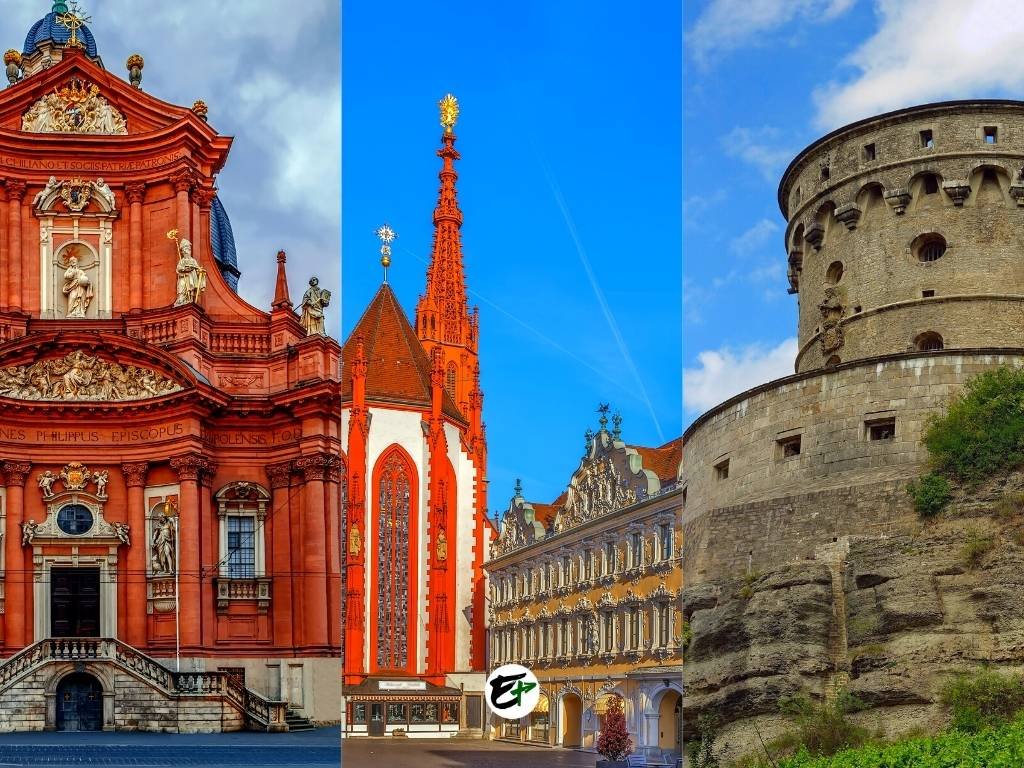
Use the table of contents to skip to topics.
Good to know: In this article, I’ll be your guide to the top experiences and discoveries that await you in Wurzburg. Not only will I introduce them to you, but I’ll also provide useful details for your visit to Wurzburg.
Find the best hotel deals in Wurzburg here.
One of the remarkable things I’ve discovered in Wurzburg is that it boasts its own UNESCO Heritage Site: Wurzburg Residence Palace. And it’s not just any heritage site — it’s home to the biggest fresco on the planet!
Wurzburg is also home to less famous but equally magnificent masterpieces and architectural feats like the Käppele Sanctuary. Contemplating these prior to your visit to Wurzburg will undoubtedly stir up excitement as you prepare to marvel at these artistic creations.
While I’m not a wine enthusiast myself, it’s noteworthy that Wurzburg provides a unique wine tasting experience. This is thanks to the city’s winemaking tradition that has been around for several centuries. Like, have you ever sampled something known as “dry white wines?”
Wurzburg has already excited you, hasn’t it? Well, everything I’ve mentioned so far is just a summary of the experiences you can have when visiting Wurzburg. Let’s delve deeper into this city, and I believe you’ll find it simply irresistible.
To me, the first reason to visit Wurzburg is this:
1. The Churches of Wurzburg and Their Architecture
Did you now that Wurzburg has been the seat of church officials since its mention in the 5th century books? This history explains the abundance of churches and monasteries in the city — the reason Wurzburg is called the “City of 100 Churches.” This unique feature of the city is, for me, a compelling reason to visit Wurzburg.
In the present day, Wurzburg is home to at least 13 Catholic churches. Additionally, several small chapels are scattered throughout the city. When compared to other regions where Christianism is the dominant religion, this number is considered above average.

Not only does Wurzburg house a large number of churches, but it also boasts some of the most stunning ones in Germany. While they might not match the grandeur of Rome’s churches, the architecture of the most prominent churches and monasteries in Wurzburg is outstanding.
Regardless of one’s faith, the churches in Wurzburg are a sight to behold. These buildings are not just places of worship, but also a reflection of the city’s rich culture. The art and architecture of these churches contribute to the unique identity of Wurzburg’s residents.
After checking each church in Wurzburg, I selected five churches. I believe you would enjoy visiting these during your trip to Wurzburg.
- Käppele Sanctuary (Wallfahrtskirche Mariä Heimsuchung)
- New Munster Church (Neumunster)
- Maria Chapel (Marienkapelle)
- St. Kilian’s Cathedral (Würzburger Cathedral)
- Augustinian Church (Augustinerkirche)
Käppele Sanctuary (Wallfahrtskirche Mariä Heimsuchung)
If you plan to hunt for the most beautiful church in Wurzburg, this church is one you should not miss. It boasts one of the most spectacular interiors in all of Wurzburg. From intricate stucco works to the finely crafted pews, it offers a visual feast.

The Wallfahrtskirche Mariä Heimsuchung, also known as Käppele, is a beautiful mid-18th-century church, with the foundation stone laid on April 5, 1748.
What makes it interesting for travelers is its unique architecture and history. Did you know that the renowned architect Balthasar Neumann, who also designed the UNESCO World Heritage Site Würzburg Residence, was involved in the renovation of this church?
It was originally built around a pietà, a statue of the Virgin Mary cradling the dead body of Jesus, erected by a local fisher in a vineyard in 1640. After several reported miracle cures associated with the statue, pilgrims began to visit the site. Today, aside from being a tourist attraction, the Käppele still serves as a pilgrimage church and it remains a popular pilgrimage site, especially at Pentecost.
When you look at the church from the outside, you’ll surely notice its unique double-towered front and a roof adorned with cupolas and roof lanterns. Inside, the church is just as impressive. The ceiling is decorated with detailed frescos by Matthäus Günther, and there’s intricate stucco work by Johann Michael Feuchtmayer the Elder.
As for the artworks, the church houses several notable pieces. The two that you must see are the ceiling frescos that depict religious themes, and the altar of the old Gnadenkapelle that still houses the original pietà from around 1640. These artworks are unique in their depiction of religious themes and their integration into the overall architectural design of the church.
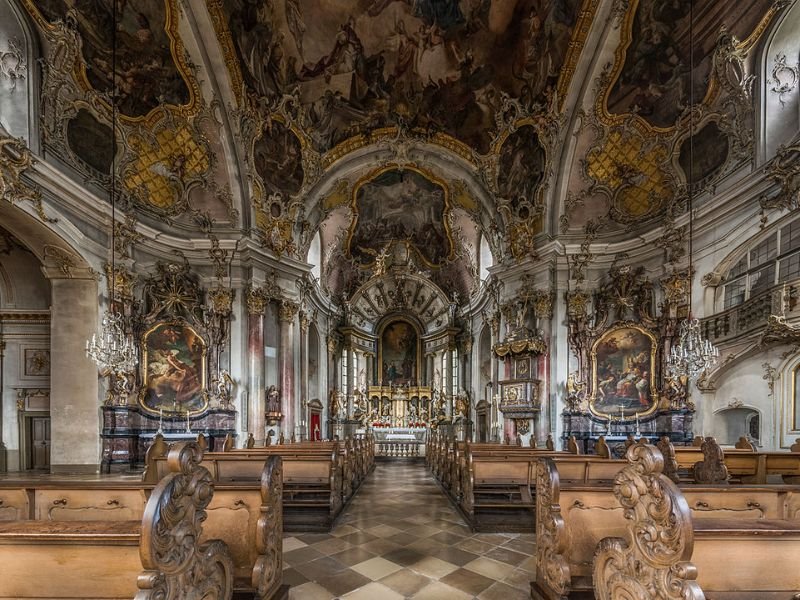
If you are planning a visit to this church, please note that it is open throughout the week and admission is free. Parking is available at no cost in the vicinity of the church. If you do not have a car, you must ride the tram to Löwenbrücke station, where you can start a 15-minute hike to the top of the hill where Käppele Sanctuary is located.
For the most recent updates and announcements, kindly refer to the official website of Wallfahrtskirche Mariä Heimsuchung in Wurzburg.
Neumünster Collegiate Church (Neumünster)
Another church in Würzburg that can make your visit worthwhile is the Neumünster Collegiate Church, or simply, Neumünster.
It’s a must-visit for travelers visiting Wurzburg, not just for its beautiful architecture and rich history, but also for the Lusam Garden. This small garden in the former cemetery and cloister of the Neumünster College of Canons is believed to be the burial place of the legendary minstrel singer Walther von der Vogelweide.
Neumünster is located in the heart of the old town of Würzburg, known as Altstadt. If you’re already in Altstadt, you can easily reach it by foot.

Today, the Neumünster serves as a parish church, dedicated to John the Baptist and John the Evangelist.
However, its origins date back to the 8th century. It was constructed by Meningoz of Würzburg as a tribute to the site where the Franconian Apostles met their martyrdom. These Apostles, namely Saint Kilian, Colman, and Totnan, were Irish missionaries who spread their faith in the Franconia region of Germany during the 7th century.
Over the years, the appearance of Neumünster has changed due to various renovations, repairs, and rebuilds. It was originally built in the Romanesque style in the 11th century. However, it has seen significant transformations over the centuries.
For instance, from 1180 to 1250, the church underwent expansion. Later, between 1711 and 1716, Josef Greising added a Baroque façade. The Zimmermann brothers took on the task of redesigning the interior in the same style, starting from 1725.
In a more recent development, the church was renovated from 2009 to 2011. This renovation saw the restoration of some Baroque elements and the installation of modern art. Inside the church, you can find art by modern artists including Michael Triegel and Hann Trier.
What makes the architecture of Neumünster so eye-pleasing is its blend of Romanesque and Baroque styles. The grandeur of its façade, the ornate decorations, and the intricate stucco work all contribute to its unique charm.
You’ll certainly appreciate the façade. It features intricate stucco work, sculptural details, and elegant columns, all of which reflect the lavish style of the Baroque period. Aside from appreciating the appearance of the Neumünster, you can also try attending a concert at the church, which is an experience not to be missed particularly during the annual Würzburg Mozart Festival.

On Sundays and public holidays, you can visit from 7:00 am to 6:00 pm, and on weekdays, we’re open from 6:00 am to 6:00 pm. Please note that on Sundays and public holidays, visiting hours are from 10:00 am to 5:00 pm, and on weekdays, you can visit from 8:00 am to 5:00 pm.
However, these hours may change due to other church services or concerts. The Neumünster is accessible for everyone, with a barrier-free entrance on the northern side leading to the Lusam Garden. For more information and guided tours, please refer to the official website of Neumünster.
Maria Chapel (Marienkapelle)
Marienkapelle, with its striking red and white exterior, is a sight to behold in Würzburg, instantly recognizable and drawing the eye of all who pass by. The stunning Gothic architecture of Marienkapelle and its association with notable figures such as Balthasar Neumann and Tilman Riemenschneider make it a site of interest in Wurzburg ranfor travelers.
In my opinion, its distinctive red and white exterior sets it apart, making it one of the most recognizable churches in the city. The towering spire, crowned with a golden Madonna, reaches for the sky, adding to the grandeur of the structure.
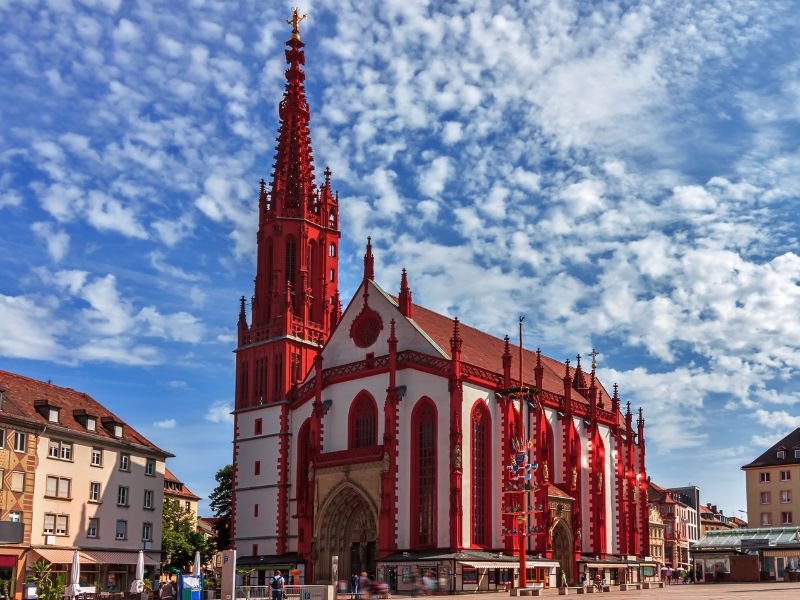
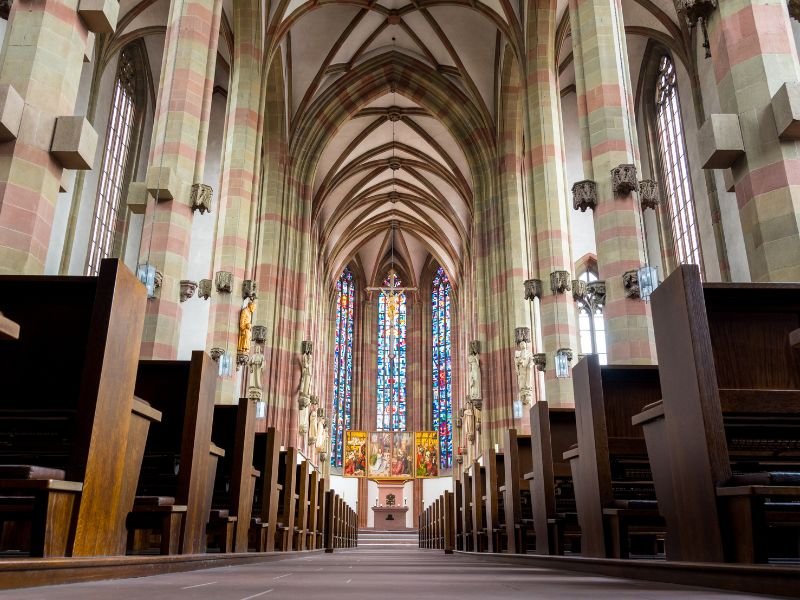
An intriguing fact about the Marienkapelle in Würzburg is its connection to a synagogue that once stood on the same site. On 21 April 1349, the synagogue was destroyed during a pogrom.
However, the reasons behind the construction of the Marienkapelle on this site are not entirely clear. Some reports suggest that the Marienkapelle was built as an act of atonement for the murder of the local Jews. Others propose it was to atone for having earlier tolerated the presence of those they referred to as Christ-killers.
Today, when you step inside, you will find yourself in a world of religious art. While Marienkapelle may not be as stunning as Sainte-Chapelle in Paris or the magnificent cathedrals in Rome, it still houses beautiful artworks. These are worth a quick stop as you explore the city center of Würzburg.
The original interior was lost to the flames of World War II, but the rebuilt chapel is home to stunning replicas of the original sculptures of Adam and Eve by Tilman Riemenschneider. These intricate works of art, now housed in the Mainfränkisches Museum in Marienburg Fortress, speak volumes about the chapel’s past.
When you visit, make sure to explore the three notable Gothic portals. Each one houses different religious works of art. For instance, the southern portal features a sculpture of Adam and Eve. The western portal, on the other hand, showcases tympanums of the Last Judgement. Finally, the northern opening displays the Annunciation.
Marienkapelle is located in Marktplatz and is open daily from 9:00 am until 7:00 pm. Entry is free.
St. Kilian’s Cathedral (Würzburger Cathedral)
Another remarkable church that you can find in Würzburg is the city’s cathedral, also known as Saint Kilian’s Cathedral. This cathedral is the center of Catholicism in the city. And interestingly, it is Germany’s fourth largest Romanesque church.
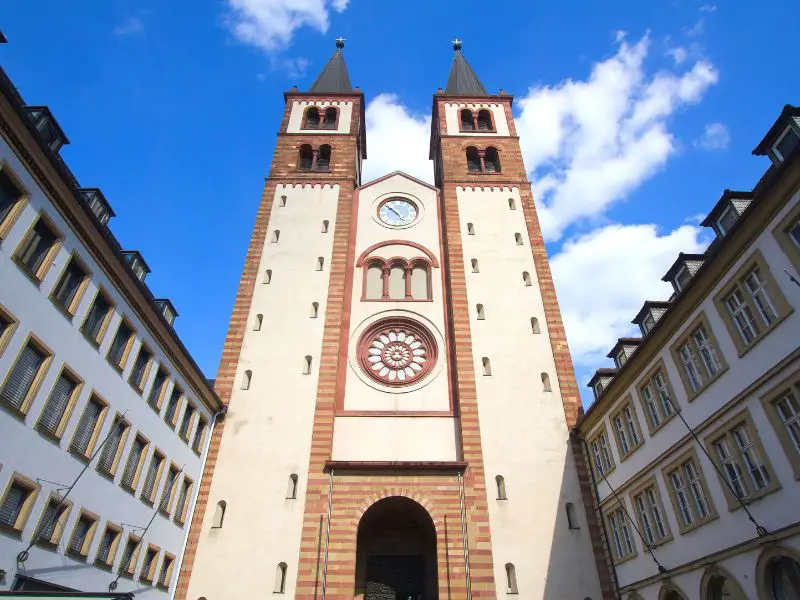
Today, the Würzburg Cathedral continues to serve as a beacon of faith and is the seat of the Bishop of Würzburg. Its rich history, impressive interiors, and association with notable figures make it a must-visit for travelers.
Believe it or not, this 11th-century cathedral has been the backdrop for several significant events, including the Imperial Diet of 1180, which saw Henry the Lion, duke of Saxony and Bavaria, banned from the Empire for three years.
Its facade, distinguished by two narrow towers, is less ornate compared to other Wurzburg churches. However, its interior is a different story.
Filled with numerous notable works of art, the church embodies the saying “do not judge a book by its cover.” Among these are a baptismal font from the 13th century, made by Eckart of Worms, and an impressive series of tombs and monumental effigies of the prince-bishops by Tilman Riemenschneider.
Balthasar Neumann, a celebrated German architect known for his elegant Baroque style, also made significant contributions to the Würzburg Cathedral. He constructed the burial chapel for the Schönborn bishops, located north of the transept, between 1721 and 1734. In addition, he added a Baroque vestry and Ornatkammer around the foot of the eastern tower in 1749.
His work beautifully complements the cathedral’s existing Romanesque and Gothic elements, adding a new layer of architectural richness to this historic structure.
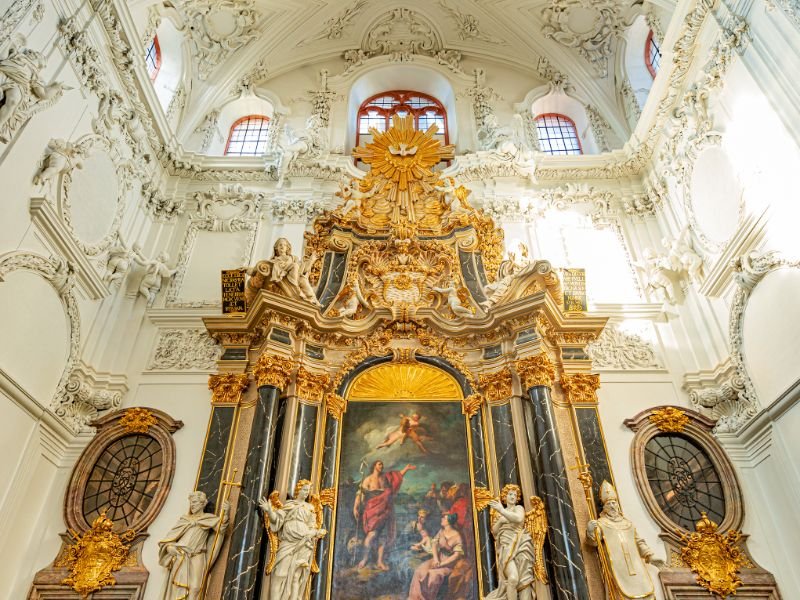
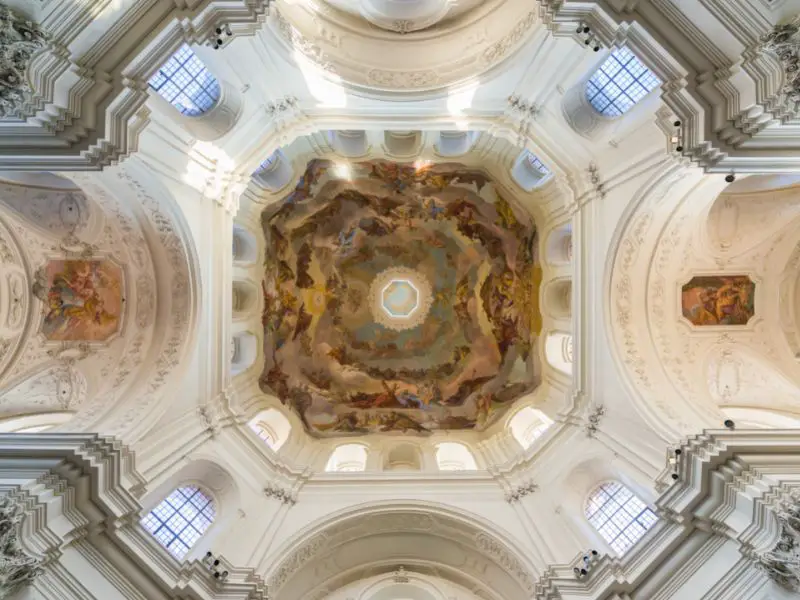
Considering a trip to the Würzburg Cathedral? You’ll be glad to know that it’s conveniently located near public transportation stops. Take a bus, tram, or train to Residenzplatz. From there, it’s just a 5-minute walk to the cathedral.
The cathedral is usually open from 10:00 am to 5:00 pm from Monday to Saturday. On Sundays and holidays, it closes a bit earlier. For the latest updates and exact opening hours, please refer to the information posted on the official website of the Würzburg Cathedral.
Augustinian Church (Augustinerkirche)
Augustinerkirche is another church in Würzburg that could appeal to religious travelers. If you’re Catholic, you can experience a unique way of celebrating the Holy Eucharist at Augustinerkirche. Here, the mass is celebrated on a table in the middle of the nave, rather than on the altar.
Another thing that makes Augustinerkirche interesting for travelers is the tale of its architectural transformation over the centuries. From its original gothic structure, it was redesigned into a baroque style, and then rebuilt after being severely damaged in World War II.
Its recent redesign in 2010-2011, which implemented the Communio model as a space-determining concept, is also a point of interest. This is why, today, the chairs and table in the church, known as the “Ambo,” are movable. This arrangement allows the churchgoers to celebrate the Holy Eucharist at eye level.
When you drop by, you’ll have the chance to see two significant pieces of art. One is a modern painting at the altar known as “The Heavenly Jerusalem.” The other is a painting that shows the Battle of Lepanto, which is the only artwork in the Augustinerkirche that made it through the World War II bombings.
The church is recognized for its beautiful organ and the concerts held there. If you wish to attend a mass or concert at the Augustinerkirche, you can refer to the calendar of events on its official website. The church is located in Altstadt Wurzburg, so it should be easy to find once you’re in the area.
2. Wurzburg Residence Palace — A Remarkable UNESCO Heritage Site
The churches of Wurzburg represent just a fraction of the architectural wonders you can discover in the city. Another highlight is the Wurzburg Residence Palace, which provides another compelling reason to visit Wurzburg.
Imagine walking into a building that’s entirely a work of art. Sounds fantastic, right? That’s exactly the experience you can expect!
In essence, the Wurzburg Residence Palace is a splendid Baroque edifice. It has been recognized by UNESCO as “one of the largest and most beautiful” palaces in Germany. This magnificent structure was erected in the 18th century by some of the finest architects and artisans from around the world, under the leadership of Balthasar Neumann.
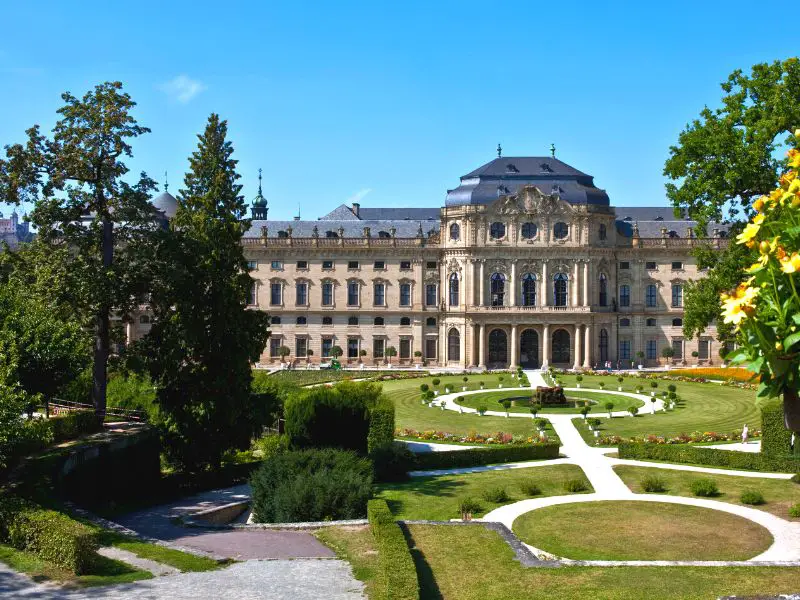
Going by UNESCO’s description of the Wurzburg Residence Palace, it’s clear that this palace is a must-visit in Wurzburg.
The palace covers a large area of nearly 15 hectares. It features two main points of interest: the palace building and the promenade.
The palace consists of two levels, each filled with numerous beautiful things to see is particularly a dream come true for wanderers. The Wurzburg Residence Palace’s ceilings and walls are themselves pieces of art! Stuccos and frescoes can be found everywhere, offering an overwhelming visual experience.
Here is a quick tour video of the Wurzburg Palace:
If palaces pique your interest, Munich is a city you must visit. This city is home to three stunning palaces that are truly a sight to behold!
In case you want to see more:
Allow me to introduce you to each part of the Wurzburg Residence Palace that I find particularly interesting.
Court Church
Among the stunning parts of the Wurzburg Residence Palace, the court church stands out. In my opinion, it surpasses the beauty of the Kappele mentioned earlier.
Notable for its curving walls and three oval dome vaults, the court church is one of the most awe-inspiring religious buildings in Germany, constructed in the 18th century. Designed by Balthasar Neumann, the chapel is a display of grandeur, with highly artistic embellishments adorning every corner.
Here are the artworks and architectural elements that you might want to lay your eyes upon during your visit to the Court Church of Wurzburg Residence Palace:
- The ceiling frescos that were painted by Rudolph Byss and his pupils. These were recreated after the war.
- The stucco decoration and stucco figures that were produced by Antonio Bossi.
- The marble sculptures of St Kilian and Burkard to the side of the high altar that were created by Johann Wolfgang van der Auwera.
- The two side altar paintings, “The fall of the angels” and “The Assumption”, are works by Giovanni Battista Tiepolo dating from 1752.
Vestibule
Not only the Court Church, but also the palace’s vestibule is worth your attention. It’s a part of the the palace that’s rich with neoclassical decorations and works of art, perfect for capturing memorable photos. It adds value to your Wurzburg trip.
In the Vestibule of Wurzburg Palace, there are four artistic and architectural elements to behold:
- Shallow vault: A remarkable technical achievement, spanning the whole area without any support. It was designed so that there was enough room in the large hall to turn a coach.
- Stuccowork: An eye-catching artwork created by Ludovico Bossi.
- Trompe l’oeil grisaille paintings: These are by Franz Anton Ermeltraut and depict the labors of Hercules.
- Marble statues: There are statues of Minerva and Bellona in the niches on the south wall by Johann Peter Wagner.
Garden Hall
The Garden Hall is another part of the Wurzburg Residence Palace that offers a visual feast. Its beauty lies in its light and graceful appearance, a credit to Balthasar Neumann.
The charm of the Garden Hall is further enhanced by the stucco decoration. Antonio Bossi created this, featuring light blue motifs on a white background. This combination creates a heavenly ambiance.
What artworks can be seen in the Garden Hall? One significant piece is the ceiling painting produced by Johann Zick in 1750. This painting depicts “The banquet of the gods” and “Diana in repose”.
Additionally, the ambulatory that is adorned with scenes of putti. These are artistic representations of a naked child, often cherubic in figure, and are typically depicted in the visual arts.
Staircase of Wurzburg Palace
The Staircase at Wurzburg Palace Residence is a highlight of the ground floor, along with the palace’s chapel. It’s something you’d want to see! The staircase is designed in an elegant Bifurcated, Baroque style. Just by stepping on it and looking around, you can feel like royalty.
The real spectacle, however, is the fresco above the staircase: “Apollo and the Four Continents”. And here’s a fun fact – with a surface area of over 600 m², this fresco is the largest in the world. Now that’s something to marvel at!
This massive artwork was brought to life by the talented Venetian painter Giambattista Tiepolo, with a little help from his son, Domenico. The fresco represents the four continents known at the time — America, Europe, Africa, and Asia — and beautifully illustrates the journey of the sun around the world. At the center of it all is Apollo, the sun god, with the sun rising majestically behind him.
What’s really intriguing is how the fresco places Würzburg and its rulers at the center of the universe. This mirrors the self-perception of the prince-bishop who commissioned the work, as well as the Eurocentric worldview of the time.
The staircase leads to the second level of the palace, where you’ll find:
- White Hall
- Imperial Hall
- Southern Imperial Apartments
- Memorial room
- Documentation room
- Tuscany Rooms
- Northern Imperial Apartments
- State Gallery
- Ingelheim Rooms
- Princes’ Hall
Personally, I think the Imperial Hall and the Imperial Apartments are the best places to visit on the second level of Wurzburg Residence Palace. But all the rooms are beautiful in their own way!
Imperial Hall
The grandeur of Wurzburg Residence Palace doesn’t end with the grand staircase – it only intensifies as you go deeper into the palace.
As you ascend to the second floor, you’re immediately welcomed by the Imperial Hall, the pinnacle of grandeur in the palace. This space is home to the ultimate display of opulence, featuring three additional ceiling frescoes by Giambattista Tiepolo.
Step into the Imperial Hall and your eyes are immediately drawn to the 20 majestic half-columns, each reaching skyward to a height of 9 meters. Adorned with intricate stucco-work marble, these columns form a large oval dome, a testament to the remarkable architecture of Wurzburg Residence Palace.
Underneath the dome, you’ll find yourself in the company of Greek gods. Antonio Bossi’s life-size stucco figures of Neptune, Juno, Flora, and Apollo stand in silent vigil, their imposing presence adding to the hall’s mystique.
Your gaze then shifts to the doors, where the artistry of Giovanni Domenico comes alive. Known as Sopraportas, his paintings grace the doors, narrating tales of ancient emperors in vivid detail. But the spectacle doesn’t end there. The walls of the Imperial Hall are a canvas of golden stucco artworks, each piece to leave a lasting impression.
Imperial Apartments
Adjacent to the grand hall lie the southern and northern royal apartments. These apartments exemplify the grandeur of German Baroque palaces. Spanning over 160 meters, they form a single luxurious suite filled with some of the world’s finest furniture.
The Royal Apartments consist of 10 rooms. Among them, the Mirror Cabinet, also known as Room #9, stands out in my opinion.
The Wurzburg Mirror Cabinet features walls made entirely of glass panels. These panels are embellished with carvings and porcelain decorations, along with stucco work.
Even though their worth can’t be reinstated, the room’s decor holds a more significant value. It is seen as the most important interior element of the Würzburg Residence. This was particularly true during the rule of Prince-Bishop Friedrich Carl von Schonborn.
3. Wurzburg’s World Class Wines, Vineyards & Cellars
Without a doubt, the churches and the Palace Residence of Wurzburg are beautiful sights in not only in Wurzburg, but also in all of Germany. They alone make a trip to Wurzburg worthwhile. Visitors will be delighted by the incredible architecture and frescoes. But there’s another reason that makes Wurzburg a must-visit: its wines.

Contrary to popular belief, Wurzburg, despite being in Bavaria, is not famous for beer but for wine. This is due to its location within Franconia, a region in Germany that’s a top wine producer. Wurzburg, in particular, is noted for its dry wines.
Believe it or not, Franconia is home to more than 300 breweries and boasts vineyards that span over 6,176 hectares (15,260 acres). These vast vineyards are where various types of grapes are grown, including the notable Riesling and Silvaner.
Interestingly, Wurzburg has a rich history of winemaking and viticulture that dates back to the middle ages. As early as 1644, the city was already enforcing strict quality control on its wines. With centuries of viticulture and winemaking practice, Wurzburg undoubtedly offers one of the best wine experiences in Europe. The city’s winemakers have even created Mariensteiner, a unique grape variety that’s a cross between Riesling and Silvaner.
But it’s not just expertise that makes Wurzburg’s wines special. The region’s soil and climate also play a crucial role. The River Main enriches the Franconian soil with a wealth of minerals, while the mild climate in Wurzburg is ideal for vine cultivation. These factors contribute to the exceptional taste of Wurzburg’s wines, making them a must-try for any visitor.
In the following sections, you’ll learn more about the places in the city where these grapes are grown, harvested, and transformed into exquisite wines. So, when you visit Wurzburg, don’t miss out on the wine tasting!
4. Marienberg Fortress and The Scenic Sights of Wurzburg
As visitors approach Wurzburg, they’re greeted by expansive vineyards that spread out like a green blanket across the landscape. It’s a picturesque view of the German countryside that’s truly a sight. This makes many believe that Wurzburg and wine are inseparably linked. And indeed, they are — both commercially and in terms of tourism.
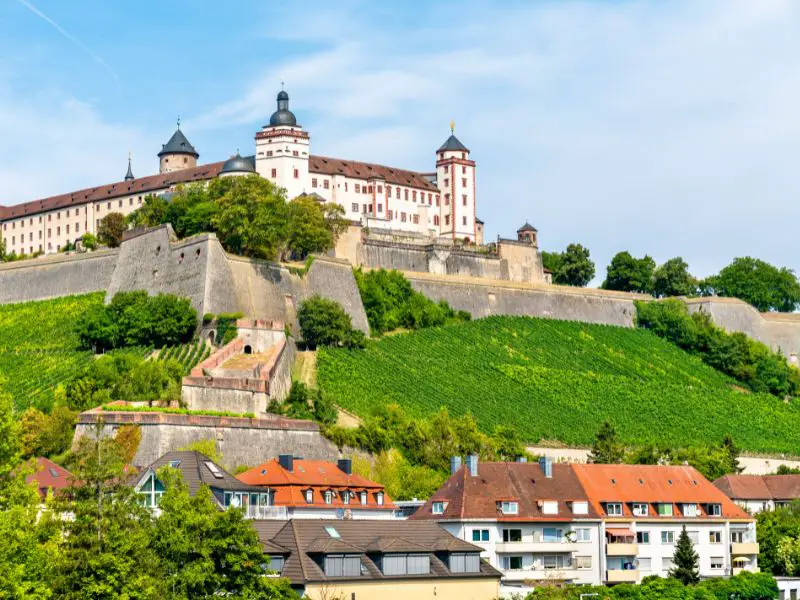
Did you know that vineyards are nestled within the city of Wurzburg itself? These vineyards are situated on a hill, the same hill where the Marienburg Fortress stands — another compelling reason to visit Wurzburg.
From its elevated position on the west bank of the River Main, the fortress provides sweeping views. You can see the vineyards, the river, and the city center. However, the Marienburg Fortress is not just about wines or the views.
The Marienburg Fortress, originating from the medieval ages, is a place where we uncover more fascinating aspects of Wurzburg: its culture and, of course, its history. This fortress has witnessed the extensive history of Wurzburg since ancient times.
But did you know Marienburg Fortress started as a small fort and only expanded a few centuries ago?
In the year 1600, the fortress was ravaged by such a great fire that everything was burned to ashes. Bishop Julius Echter, who ruled at that time, restored the building and turned it into a Renaissance castle. And after Gustavus Adolphus of Sweden conquered the area during the Thirty Years’ War, the castle was reconstructed as a Baroque residence.
The fortress’s rich history, its association with local prince-bishops, its architectural transformation over the centuries, and its current role as a museum make it a fascinating destination for travelers today.
If you will visit Marienburg Fortress, you can find different museums in it. Among them, the Main-Franconian Museum is particularly recommended. Additionally, the Prince’s Garden is a must-see for its stunning city views.
The latest information for visiting Marienberg Fortress is available on the official website of the Bavarian Palace Administration.
Main-Franconian Museum
The Main-Franconian Museum is a treasure trove of art and history nestled in the heart of Würzburg, Germany. Housed within the imposing Marienberg Fortress, the museum is a testament to the rich cultural heritage of Bavaria.
As you step inside, you’ll be greeted by a vast collection of paintings, sculptures, and crafts that span several centuries. The museum’s permanent exhibitions are a journey through time, showcasing the evolution of art and craftsmanship in Würzburg and Main-Franconia from the early periods to the 19th century.
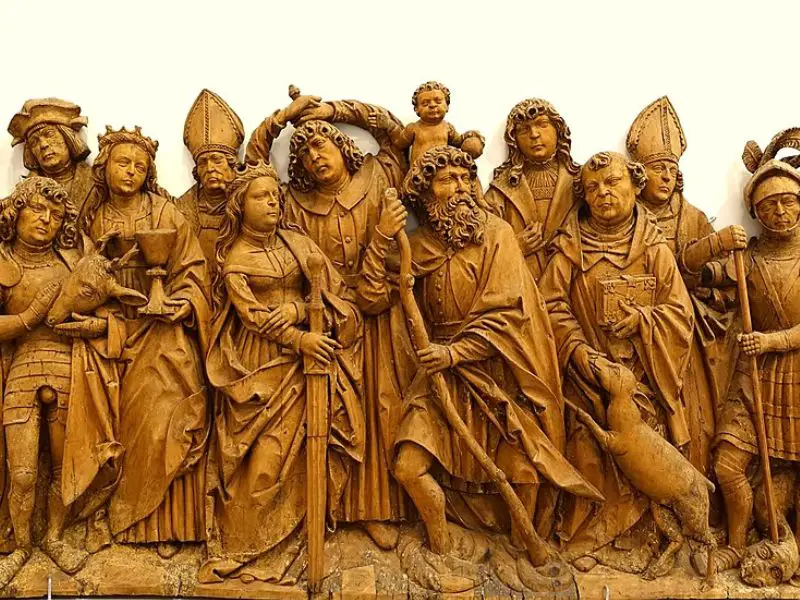
One of the highlights of the museum is the world’s largest collection of works by Tilman Riemenschneider, a renowned sculptor and woodcarver of the Late-Gothic era in Germany. His masterpieces, including the carved altarpieces in Münnerstadt, Rothenburg, and Creglingen, are a sight to behold.
Overall, the museum is home to 81 intricately carved wooden sculptures by Riemenschneider. These sculptures are some of the most detailed wooden artworks you’ll ever encounter! To me, the two standout pieces by Riemenschneider in the Main-Franconian Museum are Adam and Eve and Grieving Maria.
The museum provides a variety of experiences for visitors. You have the option to participate in a guided tour, workshop, project, or event series. For the most recent information on visiting the Main-Franconian Museum, please consult the official website of Germany Tourism or the museum’s website.
Prince’s Garden
During your visit to Marienberg Fortress, make sure to visit the Prince’s Garden. This garden adorns the east side of the fortress and offers a peaceful retreat.
The garden features artistic terraces, grand balustrades, and cascades that reflect the influence of Prince-Bishop Johann Philipp von Schönborn. The parterre is divided into eight sections filled with flowers and is adorned with a fountain, inviting you to stroll around.
Adding to the garden’s charm are two pavilions on the upper terraces, believed to be the work of Josef Greising. The southern pavilion, in particular, is known for its intricate late baroque stucco decoration.
Perhaps the most captivating aspect of the Prince’s Garden is the breathtaking view it offers. It overlooks Würzburg and the River Main valley, extending to Randersacker and the Nikolausberg with the Käppele. The garden provides a panoramic vista that is truly unforgettable. It’s the perfect spot to unwind and soak in the beauty of the surroundings.
5. Other attractions and things to do in Wurzburg
The Wurzburg Residence Palace and the churches are not the only attractions in Wurzburg. A visit to the Prince’s Garden reveals other points of interest in the city. One such point is the Old Main Bridge.
On a sunny day, the Prince’s Garden in Marienberg offers a stunning view of the city. The sight of the bridge stretching across the calm blue waters of the River Main is particularly captivating.
Other attractions are the following:
- Maschikuli Tower
- Juliusspital
- Falcon House
- Japanese Garden
- Veitshöchheim Palace
The reason I mention this is because Wurzburg’s appeal extends beyond its main attractions. The city also boasts lesser-known destinations that could be considered hidden gems. Allow me to introduce each of them to you.
Old Main Bridge
First on side attractioon in Wurzburg is the Old Main Bridge, a prime location in Wurzburg for sightseeing. From here, you can view the vineyards, Fortress Marienberg, and Kapelle.
The Old Main Bridge was constructed in the mid-20th century. Its purpose was to connect the two parts of Wurzburg that are separated by the Main River. On the left bank of the River Main is the Former Fisher’s Market, and on the right bank is the Old Town of Wurzburg.
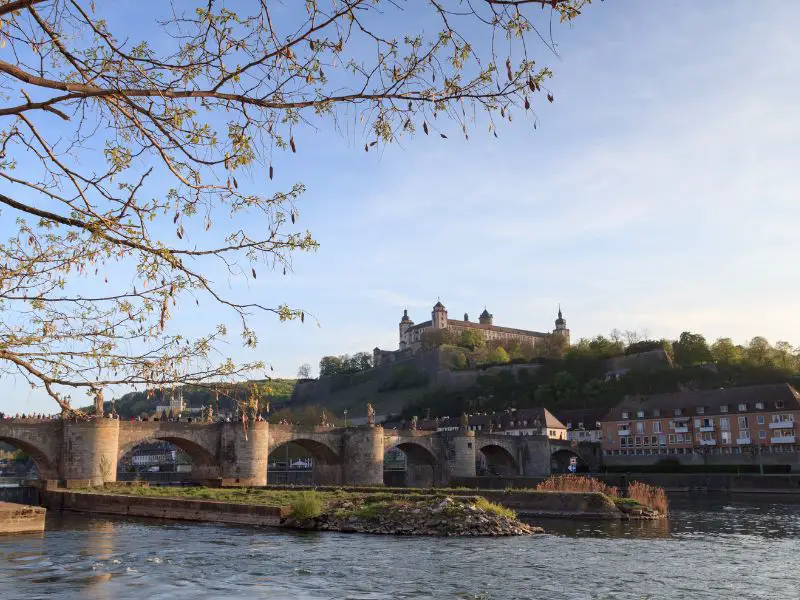
Today, the Old Main Bridge serves as a pedestrian zone. It is primarily used for social events and sightseeing by tourists. On warm summer nights, the bridge transforms into a social hub. Here, travelers and locals gather to enjoy the famous Franconian Wine and form new friendships.
For everyone visiting Wurzburg, the bridge offers a relaxed setting for a walk. Visitors can admire the view of the Main River, observe historic buildings and churches. A unique feature of the bridge is the row of statues that line its sides. These statues depict various saints and historical figures from the 18th century.
Several restaurants and cafes are located on the bridge. These establishments offer local cuisine and drinks, which visitors can savor while taking in the views.
Maschikuli Tower
A short stroll from the Marienberg Fortress will bring visitors to the Maschukuli Tower. It was built between 1724 and 1729 by Balthasar Neumann, with the purpose of guarding the south flank of the fortress. The tower was designed to house heavy artillery and riflemen, a testament to its military significance.

One of the notable features of the tower is the 21 vertical openings, or “Maschikulis”, which give the tower its name. The tower is also adorned with the coats of arms of Prince Bishop Christoph Franz von Hutten, a work dating from 1727.
If you’re interested in German history, particularly events like the Peasant’s Revolt, the Maschikuli Tower in Wurzburg is a must-visit. Its very presence seems to whisk you away to a different era. The scars on its walls from heavy artillery and rifle guns are mute testaments to the numerous battles that have taken place in the city.
You have the opportunity to explore this four-storey tower for a small cost. The tower accommodates three levels for heavy artillery and a separate platform for riflemen. Please visit the official website of the Bavarian Palace Administration for up-to-date information about Maschikuli Tower.
Juliusspital
If you are visiting Wurzburg, another place to add to your itinerary is Juliusspital. This site is not only Germany’s second-largest wine estate, but it also holds the record for being the largest Silvaner wine estate globally!
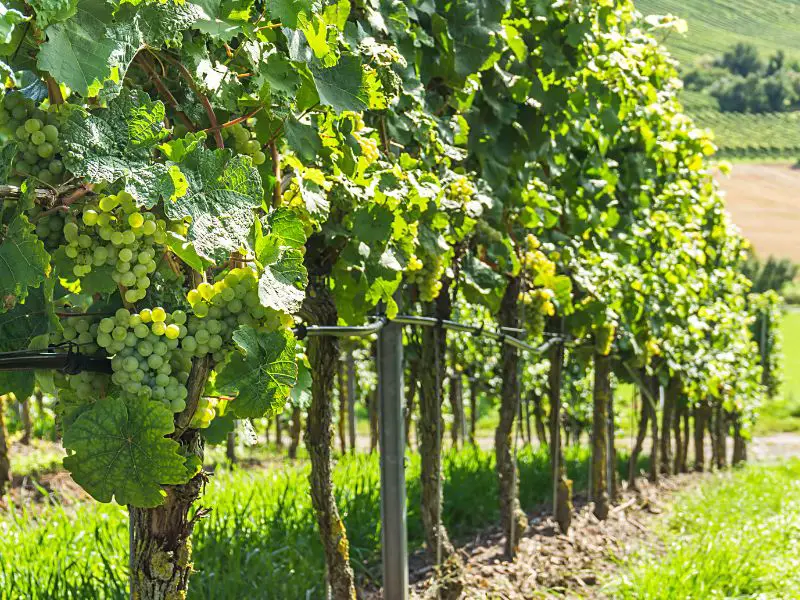
Stiftung Juliusspital Wurzburg, a charitable foundation, manages the wine estate. The profits they generate contribute to their social responsibilities.
They collect grapes from their vast vineyards and transport them to their base in Wurzburg. There, you can tour and observe the impressive cellars where they craft their wines. These cellars find their home in the Princes’ Building or Fürstenbau.
Inside, you’ll discover 250 ancient barrels containing 10,000 hectoliters of wine! Don’t miss the wine tasting experience when you visit Juliusspital in Wurzburg.
With a history spanning over 440 years, Juliusspital has mastered winemaking. The wines they create will treat your taste buds to unique Franconian flavors.
The main site of Juliusspital in Wurzburg also boasts a sophisticated baroque hospital complete with a church and a courtyard.
For a more comprehensive understanding of Juliusspital, consider visiting their official website. It offers valuable information for visitors and highlights the diverse experiences they provide.
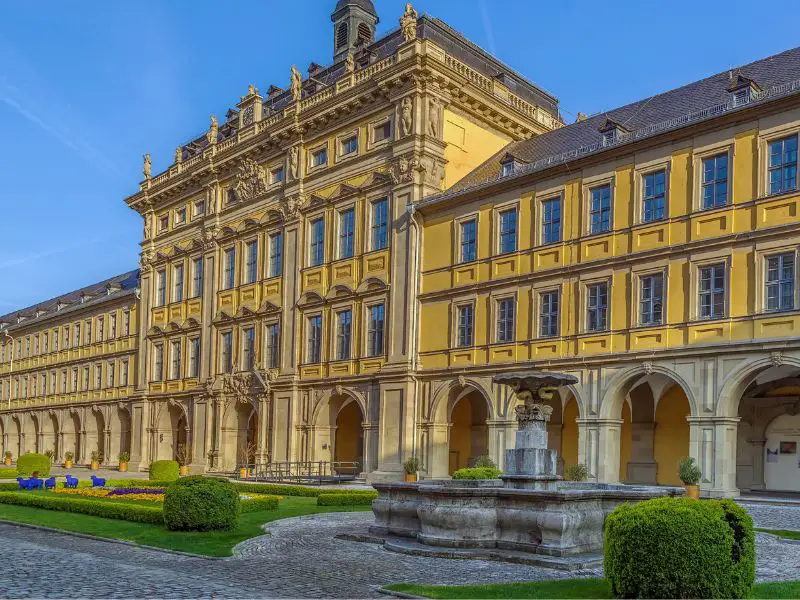
For those with a passion for vineyards and wine tasting, Reims, the core of the Champagne Region, Verona, home to Northern Italy’s finest wines, and Geneva, located closest to the UNESCO Heritage Site of Lavaux Vineyard, are worth considering. They are great alternatives to Wurzburg in this matter.
Falcon House
For those who love architecture, the Falcon House is a sight to behold. Situated behind the lovely Marienkapelle, this former priest’s house captivates many with its stunning facade, deemed one of the most beautiful rococo facades in southern Germany. Inside, it features a library, a peaceful haven for visitors seeking respite within the city.
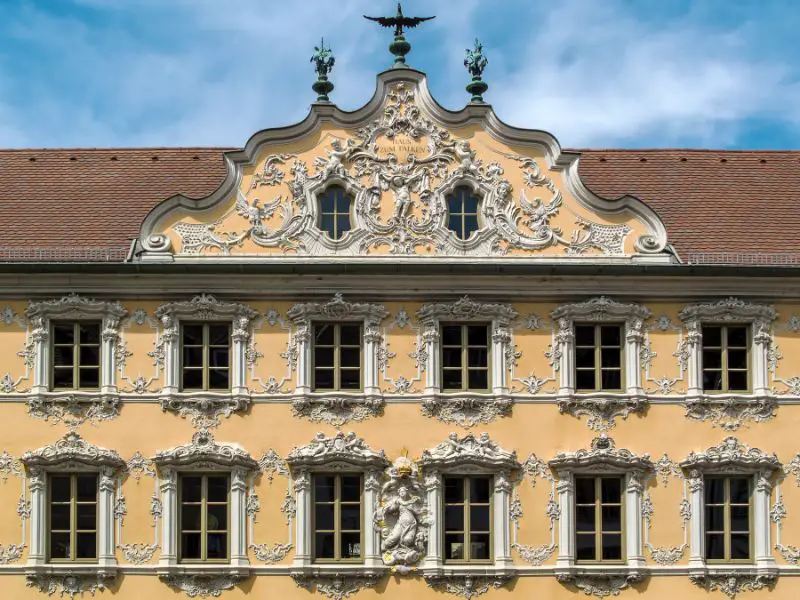
Japanese Garden
If you’re in the mood for something distinctly Eastern, Wurzburg offers a Japanese Garden for you to explore. Similar to the Falcon House, this place provides a peaceful retreat, but with an added touch of nature. A walk in the garden will make you feel as if you’ve been transported to Japan. You’ll encounter various Japanese elements, from ponds and lanterns to Koi fish and cherry blossom trees.
The Japanese garden is situated to the north of Marienberg Fortress, amidst other small gardens. It’s a 20-minute walk from the fortress.
Veitshöchheim Palace
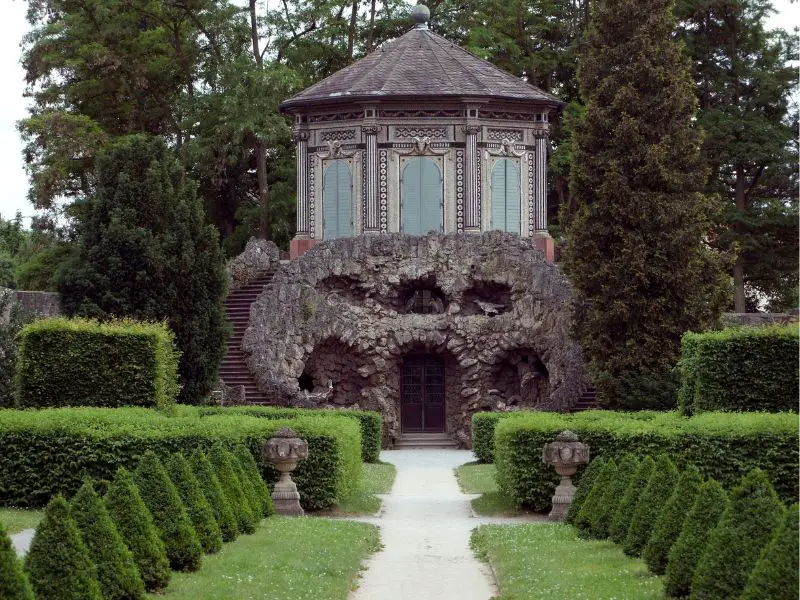
Last but not least is the Veitshöchheim Palace, situated in the outskirts north of Wurzburg.
Veitshöchheim Palace, also known as Schloss Veitshöchheim, is a stunning late Baroque palace. It was built between 1680 and 1682 as the summer residence of the Prince-Bishops of Würzburg, under the stewardship of Peter Philipp von Dernbach.
The palace underwent expansion in 1753 by the renowned German architect Balthasar Neumann. And since 1814, the castle has been in the possession of the Bavarian Crown and served as a summer palace for the royal family in the 19th century.
In 1810, some rooms received decoration for Grand Duke Ferdinand of Tuscany, showcasing extremely rare paper wallcoverings. Today, the palace and gardens belong to the Free State of Bavaria and have been open to the public as a museum since 1932.
A visit to the Veitshöchheim Court Garden is an unmissable experience at the palace. This magnificent rococo space is adorned with beautiful lakes and water features, offering a sight to behold.
The garden, home to over 200 sandstone sculptures, captivates visitors. These intricate pieces depict various deities, animals, and allegorical figures, each telling a story of its own. This cosmological design portrays Veitshöchheim Palace as ‘the symbol of heaven’, making it an intriguing destination for travelers.
To make your visit worthwhile, consider picking up an audio-guide. This allows you to explore at your own pace and soak in the rich history and beauty of the palace and its gardens. A scenic boat trip from Würzburg to Veitshöchheim castle might also enhance your experience.
Check out the Bavarian Palace Administration Website for all the details on Veitshöchheim Palace. It’s got everything from opening times to guided tour information and the most recent entry fees.
When to Visit Wurzburg
Are you planning to visit Wurzburg?
In my view, Wurzburg, with its array of tourist attractions and experiences, is a destination worth visiting any time of the year. The city’s highlights, such as the churches, Wurzburg Residence Palace, and Marienberg Fortress, are accessible year-round.
However, a summer visit is preferable as the visiting hours for various attractions are extended, allowing you to explore more in a day. Be aware, though, that summer is also the peak season, so expect a larger crowd of tourists exploring Wurzburg’s secrets alongside you.
If you’re seeking the best weather, consider visiting between late May and mid-September. During this period, Wurzburg is at its most charming, with pleasant temperatures ideal for city exploration and enjoying the beautiful surroundings.
Budget constraints? No worries! The most economical time to visit Wurzburg is during the winter months, from December to February. At this time, you can find hotel rates averaging around $118 per night. In contrast, the summer months, from June to August, are the peak season with hotel rates averaging $139 per night. This means you could save around $21 per night by visiting in the winter!
Wurzburg is a city that loves to celebrate. There are several events throughout the year that offer a unique experience of the local culture. To make your trip to Wurzburg more memorable, consider timing your visit with these events. You can check Wurzburg’s calendar of events here.
How Many Days in Wurzburg
Two days are typically sufficient to explore the highlights of Wurzburg. This itinerary could include a stroll through Altstadt Wurzburg, visits to a few churches, a trip to Marienberg Fortress for a panoramic city view and museum tour, a guided tour of Wurzburg Residence Palace, and a journey to the city’s vineyards for wine tasting.
However, if time is limited, a single day can be enough to see the best of Wurzburg, primarily the Residence Palace and Altstadt. In fact, these highlights can be experienced on a day trip from nearby cities such as Nuremberg, Munich, or Stuttgart.
How to Get to Wurzburg
If you’re planning a trip to Würzburg, whether you’re jetting into Germany or already in the country, you’ve got plenty of choices. Nuremberg, Stuttgart, Munich, and even Frankfurt can serve as your starting points.
If you’re starting from Nuremberg, you have a couple of options. You can hop in a car and enjoy a scenic drive to Würzburg, which takes around 1 hour and 35 minutes. Or, if you prefer public transport, you can catch a Deutsche Bahn Intercity-Express train, which will get you there in about 1 hour and 18 minutes.
Coming from Munich? The car journey is a bit longer, around 2 hours and 52 minutes. But don’t worry, the train is a great alternative. The Deutsche Bahn Intercity-Express runs a service every 3 hours, and the journey takes approximately 2 hours and 4 minutes.
Starting from Stuttgart? You’re looking at a car journey of around 1 hour and 44 minutes. If you’d rather sit back and relax, there’s an hourly train service operated by Go Ahead BW, which takes about 2 hours and 12 minutes.
As for airports, the closest one to Würzburg is in Nuremberg. But, there are also good connections from Frankfurt airport with an hourly train service. And if you’re flying into Stuttgart, FlixBus operates a bus service from the airport to Würzburg Main Station twice daily.
Where To Stay in Wurzburg?
Planning a 2-day or longer trip to Wurzburg? Consider booking a hotel in Altstadt Wurzburg, especially if you’ll be using public transportation. From there, you’ll have easy access to many tram, train, and bus routes that connect to different parts of the city and attractions in the vicinity. It’s all about making your trip as convenient as possible.
If you’re ready to start planning your trip to Wurzburg and need a place to stay, this link will help you find the best hotel deals in Wurzburg.
How to Get Around Wurzburg
Navigating Würzburg is a breeze, all thanks to its well-organized public transportation system. Würzburg’s compact size and efficient public transportation make it simple to hop from one attraction to another.
The city boasts a network of trams and buses that can whisk you away to various parts of the city and attractions nearby. With five tram lines circling the city and eighteen bus routes serviced by a fleet of buses, getting around is easy. Plus, an all-day ticket for unlimited travel on both trams and buses is just 4 Euros.
Do you need a car in Wurzburg?
Exploring the old town of Würzburg doesn’t require a car as it’s perfectly walkable. In fact, a leisurely stroll through the old town is a great way to soak in the city’s charming architecture and lively atmosphere.
However, if you’re planning to venture outside the city or if you enjoy the convenience of driving, car rental services are at your disposal. Just bear in mind that while driving in Würzburg is doable, the streets can be narrow and parking might pose a challenge in some areas.
Where To Go Next After Wurzburg?
Looking for picturesque spots and charming towns where you can delve into the captivating German culture?
I’ve got some recommendations for destinations you might want to check out before or after your Würzburg adventure. As you may know, Würzburg is nestled in Bavaria, one of the two southern states of Germany, which, in my view, boasts some of the country’s best places to visit. And since you’re in Würzburg, you’re just a stone’s throw away from:
- The most enchanting tourist attractions in Germany, such as Neuschwanstein Castle, Lichtenstein Castle, and the Black Forest.
- The areas with the most stunning views in Germany, like Garmisch-Partenkirchen, Mittenwald, Oberammergau, and Berchtesgaden.
- Towns and cities brimming with historical landmarks that take you on a journey from the era of the Holy Roman Empire to World War II, including Bamberg, and Rothenburg ob der Tauber.
You can find a summary of these places in my post: Southern Germany’s 10 Most Beautiful Places. And if you’re keen on visiting the towns with the best views, check out my Bavarian Alps itinerary.
How about places to visit outside Germany? What can I recommend? Consider exploring cities in nearby countries such as France, Italy, and Switzerland that have a vibe similar to Würzburg. These cities, much like Würzburg, feature landmarks with impressive architecture and artworks.
- Paris — You must see Sainte-Chapelle, and there are just too many to mention! I listed here my top glorious and phenomenal landmarks in Paris.
- Reims — It was in this city that the kings of France held their coronation. The church where they conducted the coronation is a marvel of Gothic architecture! Take a look at Reims Cathedral here.
- Venice — It’s not only about overcrowded canals! The grandeur of the buildings in Venice is superb. Some of them have unbelievable beauty inside and outside. Discover the most beautiful buildings in Venice here.
- Florence — Florence Cathedral will drop your jaw to the ground when you see it. It’s stunning, overwhelming you with details. View all the beautiful places in Florence here.
- Rome — Sistine Chapel’s frescoes can match the spectacle of Wurzburg Residenz Palace’s staircase frescoes. See all the beautiful landmarks in Rome here.
- Bern — I bet you’ll love the architecture of its Old Town, which is considered a UNESCO site. Learn more about Bern, Switzerland, here.
Photos to Inspire You Visit Wurzburg
If you are not still convinced if you’ll visit Wurzburg or not, I’ll leave you these photos captured in the city to inspire you to go and see them.
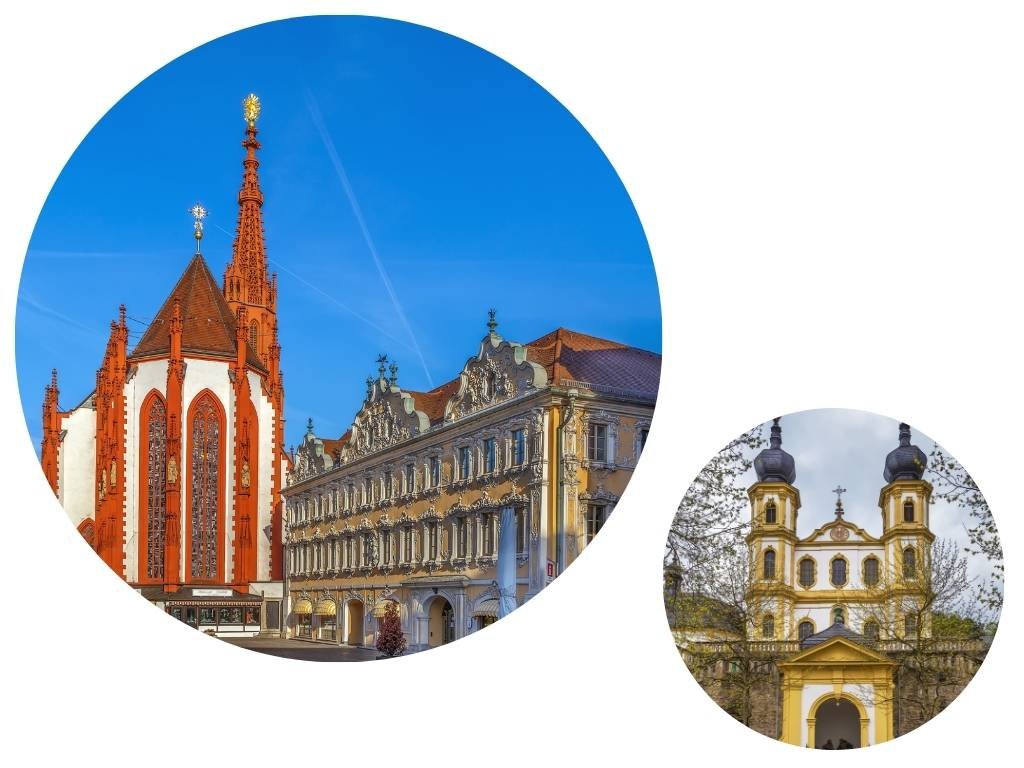

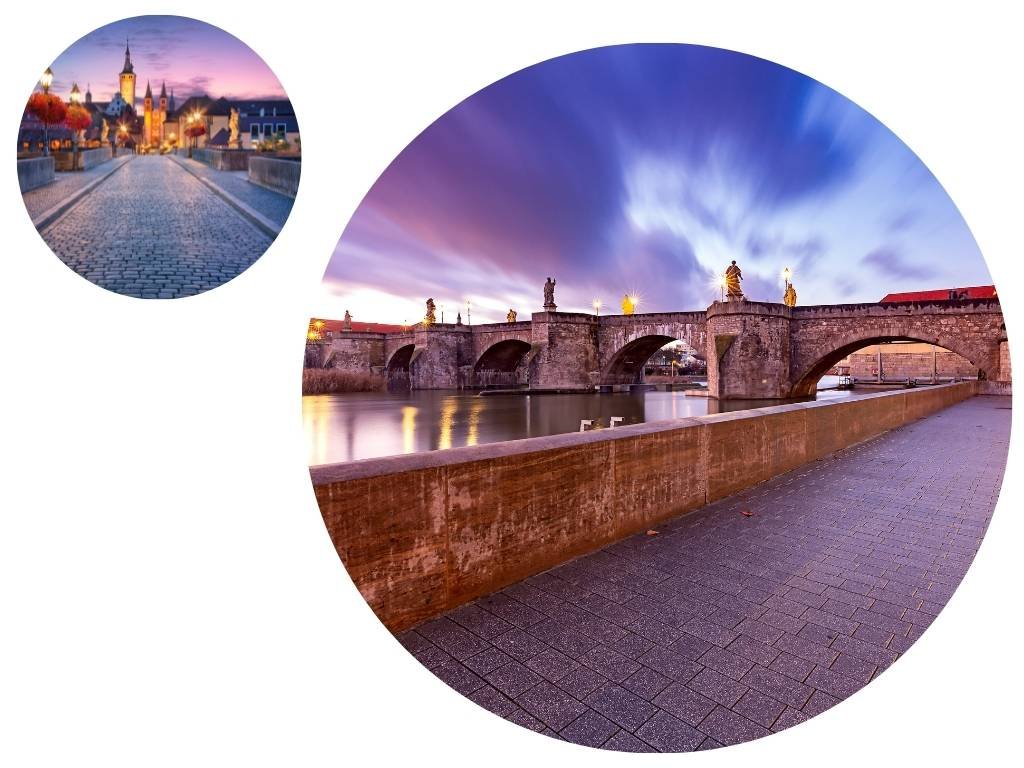

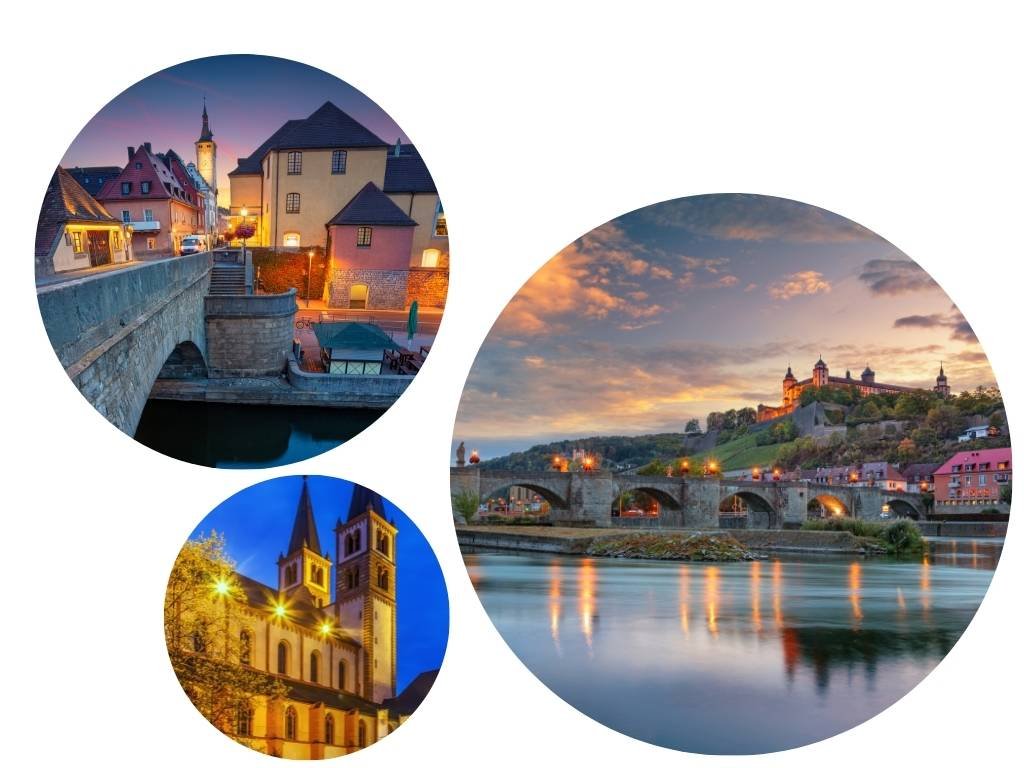
Save it on Pinterest.








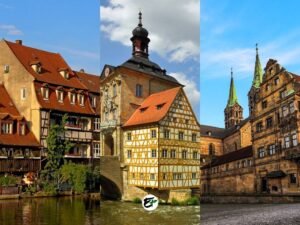
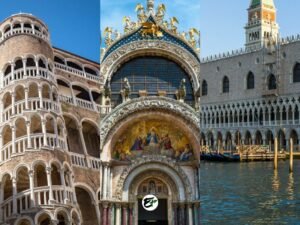

Τhanks foг sharing your info. I really appreciate your efforts and I am waiting for your further post thank you once again.